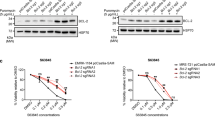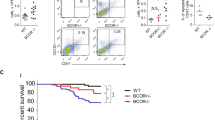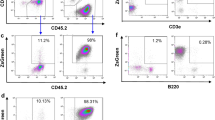Tissue invasion by leukaemic cells is stalled by loading them with a designer ribozyme.
Abstract
Chronic myelogenous leukaemia (CML) is a haematopoietic malignant disease associated with the expression of a chimaeric BCR–ABL gene1,2. We have designed an allosterically controllable ribozyme that specifically cleaves BCR–ABL messenger RNA and induces apoptosis in cultured CML cells3, and here we test it as a possible treatment of CML in a mouse model. We find that this ribozyme completely inhibits tumour-cell infiltration in these mice. To our knowledge, this is the first application of an artificial, allosterically controllable enzyme in animals, opening up the possibility of using ribozyme technology in the treatment of CML.
This is a preview of subscription content, access via your institution
Access options
Subscribe to this journal
Receive 51 print issues and online access
$199.00 per year
only $3.90 per issue
Buy this article
- Purchase on Springer Link
- Instant access to full article PDF
Prices may be subject to local taxes which are calculated during checkout

Similar content being viewed by others
References
Bartram, C. R. et al. Nature 306, 277–280 (1983).
Konopka, J. B., Watanabe, S. M. & Witte, O. N. Cell 37, 1035– 1042 (1984).
Kuwabara, T. et al. Mol. Cell 2, 617–627 (1998).
Daley, G. Q., Van Etten, R. A. & Baltimore, D. Science 247, 824– 830 (1990).
Gishizky, M. L. & Witte, O. N. Science 256, 836–839 (1992).
Amontov, S. & Taira, K. J. Am. Chem. Soc. 118, 1624–1628 (1996).
Kuwabara, T. et al. Nature Biotechnol. 16, 961– 965 (1998).
Kuwabara, T., Warashina, M., Nakayama, A., Ohkawa, J. & Taira, K. Proc. Natl Acad. Sci. USA 96, 1886–1891 (1999).
Onishi, M. Exp. Hematol. 24, 324–329 (1996).
Snyder, D. S. & McGlave, P. B. Hematol. Oncol. Clin. North Am. 4, 535–557 ( 1990).
McGlave, P. B. et al. Blood 81, 543–550 (1993).
Deisseroth, A. B. et al. Blood 83, 3068 ( 1994).
Tanabe, T. et al. Biomacromolecules 1, 108– 117 (2000).
Author information
Authors and Affiliations
Corresponding author
Rights and permissions
About this article
Cite this article
Tanabe, T., Kuwabara, T., Warashina, M. et al. Oncogene inactivation in a mouse model. Nature 406, 473–474 (2000). https://doi.org/10.1038/35020190
Published:
Issue Date:
DOI: https://doi.org/10.1038/35020190
This article is cited by
-
Trichosanthin down-regulated p210Bcr-Abl and enhanced imatinib-induced growth arrest in chronic myelogenous leukemia cell line K562
Cancer Chemotherapy and Pharmacology (2007)
-
Effective transduction and stable transgene expression in human blood cells by a third-generation lentiviral vector
Gene Therapy (2003)
-
Identification of genes that function in the TNF-α-mediated apoptotic pathway using randomized hybrid ribozyme libraries
Nature Biotechnology (2002)
Comments
By submitting a comment you agree to abide by our Terms and Community Guidelines. If you find something abusive or that does not comply with our terms or guidelines please flag it as inappropriate.



